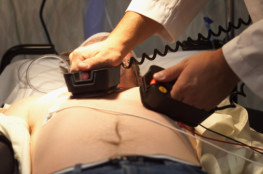Group Aims to Cut High Death Rate of Patients Who Suffer Heart Attacks in Hospitals
11February2015
11February2015

Twelve hospitals are working together to develop strategies to improve the outcome and speed of treatment for patients who suffer a heart attack while they are in the hospital being treated for something else.
Recent studies show that people who suffer a heart attack while in the hospital are three times more likely to die before getting discharged than people who come to the hospital seeking treatment for a heart attack, according to an article in The Wall Street Journal. The 12 hospitals want to change that.
The article reports that researchers estimate 10,000 people have a heart attack each year while being treated in a hospital for conditions such as pneumonia or cancer or while undergoing a procedure such as a knee or hip transplant.This accounts for about 5 percent of major heart attacks in the United States each year.
“With teams put together in a system, you can have better outcomes,” said Dr. Sidney Smith, a cardiologist at University of North Carolina at Chapel Hill who is spearheading the project in the article. “We can save some lives.”
The group plans to work on developing strategies that include having rapid-response teams in heart catheterization labs and involving nurses from non-cardiac units.
Many of the heart attacks that patients have in the hospital are caused by a clot that blocks one of the major arteries that delivers blood to the heart, according to the Wall Street Journal article. The longer the block is in place, the more serious the heart attack is, increasing the damage to the heart muscle. Doctors call these heart attacks “STEMIs” after the electrocardiogram (ECG) pattern that shows the total blockage.
Most hospitals have protocols in place to quickly treat someone who arrives in the emergency room having a serious heart attack and an ECG reveals a major blockage.Patients already in the hospital are often already quite sick and the heart attack may be harder to diagnose. But even after the diagnosis, studies show it can take twice as long to treat these patients with a potentially lifesaving stent procedure as compared to patients who arrive in the ER with heart attack symptoms.
A University of North Carolina study published in the Journal of the American Heart Association in 2013 looked at 275 STEMI patients between 2007 and 2011. It found that 40 percent of the 48 patients who suffered attacks in the hospital died before being discharged, compared with 4 percent of the patients who came to the ER for treatment of a heart attack.
The Wall Street Journal article reported the study found that 16 of the 48 inpatient heart attack victims reported their own symptoms, with the rest being noticed by nursing staff.
“They’re higher-risk patients to start with, but they’re also getting suboptimal care,” Dr. Tim Henry, director of cardiology at Cedars Sinai Medical Center in Los Angeles, said in the article.
Another study by University of North Carolina researchers last year looked at 62,000 patients at 303 hospitals and found that 34 percent of those who had heart attacks while in the hospital died before they could be discharged. Among patients who came to the ER with heart attack symptoms, only 9 percent died. Further, according to the Wall Street Journal article, 65 percent of the ER patients underwent a procedure to unblock an artery, compared to just 22 percent of the in-hospital patients.
The 12 hospitals working on the project are aiming to even out those numbers. The Wall Street Journal article reported the project has three steps: educate nurses in non-cardiac units to recognize signs of a heart attack; order an ECG immediately to check for signs of blocked arteries; and establish a protocol in which a positive ECG immediately activates a rapid response to get the patient to a catheterization lab for treatment.
The attorneys of Morrow Kidman Tinker Macey-Cushman, PLLC represent patients who have been harmed by preventable medical errors in Seattle and across Washington, including patients who were injured because a hospital failed to properly diagnose and treat a heart attack.